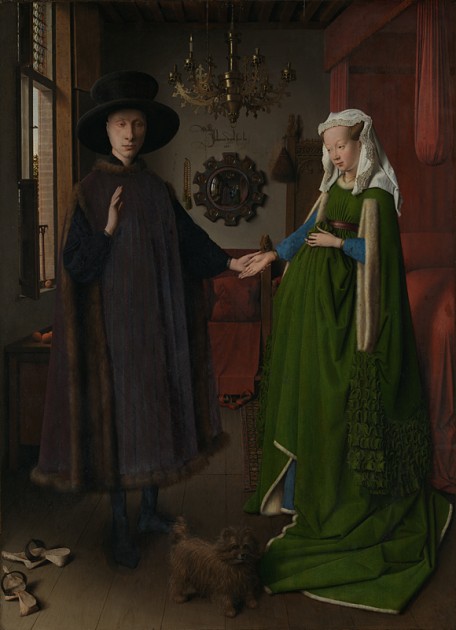Monday, February 15th, 2021
“The Arnolfini Portrait” and “La Belle Iseult”
Over the weekend, I listened to author and curator Suzanne Fagence Cooper present a Zoom lecture titled “At Home with Jane and William Morris,” drawing information from a book scheduled to come out next year. I was especially interested in the passing comment that Cooper made about William Morris’s painting La Belle Iseult (1858, shown below). This is the only completed oil painting by William Morris that exists; today his work in the arts is more closely associated with designs of tapestries and wallpaper prints. However, early in his career (when he fell under the beguiling spell of Dante Gabriel Rossetti), Morris tried his hand at painting. The model for this painting is Jane Burden, who would marry William Morris the following year in 1859.

William Morris, “La Belle Iseult,” 1858. Oil paint on canvas, 71.8 x 50.2 cm. Photo © Tate. Available through Creative Commons License CC-BY-NC-ND 3.0 (Unported)
Suzanne Fagence Cooper mentioned how this painting is has some similarities with Jan Van Eyck’s painting The Arnolfini Portrait (1432), with the positioning of Iseult’s body matching the turned pose and voluminous drapery folds of the Arnolfini wife, in addition to the inclusion of oranges on the right side. In comparing the two paintings side by side, the folded up bed curtains on the right side also have similarity in composition. Both paintings also include carpets, dogs, mirrors, and slippers.

Jan Van Eyck, “The Arnolfini Portrait, 1432. Oil on oak, 82.2 x 60 cm. Photo © Tate. Available through Creative Commons License CC-BY-NC-ND 3.0 (Unported)
The Arnolfini Portrait was purchased by the National Gallery (London) in 1842. The influence of the Arnolfini Portrait on the Pre-Raphaelite Brotherhood (and William Morris, but extension) was highlighted in a 2018 exhibition Reflections : Van Eyck & the Pre-Raphaelites. In fact, La Belle Iseult was included as part of the show and was promoted online an attraction.
I haven’t been able to find a photograph of this painting that includes an image of the original frame by Morris, but this article mentions that the phrase “As I can” is included, as a nod to the phrase that Van Eyck would use in when signing many of his paintings. (If anyone has or knows where there is a photograph of this frame online, please share!) It seems to me that La Belle Iseult also includes a humble acknowledgement of William Morris’s shortcomings as a painter, not only in contrast to his peers Edward Burne-Jones and Dante Gabriel Rossetti (as others have noted), but specifically Jan Van Eyck: the back of the painting includes the inscription “I cannot paint you; but I love you.” It seems to me that this inscription also is intended to complement and echo the “as I can” sentiment on phrase on the frame.
While William Morris may have sensed his limitations as a figural painter, Suzanne Fagence Cooper pointed out how La Belle Iseult indicates Morris’s strengths in pattern design. The carpets, tapestry, drapery pattern all are meticulously painted and are the greatest strengths of this painting. In fact, I think that these patterns are part of the greatest tribute to Jan Van Eyck, since he paid attention to minute details and was very interested in reproducing the likeness of fabrics and textures.
So great. As I scrolled down to the image and the figure’s head came into view my first thought was, “Hmm, Pre-Raphaelite lite,” then as I saw the drapery, “how apropos and so Van Dyke Flemish, even down to the table runner with the creases.”
The creases always get me. Definitely a “look at what I can do” painter thing. I also love the expression on her face. I wonder what Christmas festivity she is wanting to get out of.
Many thanks for this post.
Morris’ tapestries, carpets etc were full of complex images, religious, medieval and otherwise. So I wonder why Belle Iseult (1858) was the only completed Morris oil painting still surviving. Did he paint others and they weren’t received well? Did he feel there was too much competition in the painting world? Were paintings too expensive for his target market?
Hi Hels! Thanks for your comment! As far as I can tell, I don’t think Morris attempted other paintings beyond this one. I think that he realized his visual skills lay elsewhere as a designer (hence the “I cannot paint you” inscription), and he probably decided to leave painting to his friends Dante Gabriel Rossetti and Edward Burne-Jones. One other point I should acknowledge, though, is that Morris did work on fresco murals at Oxford Union library (see video) although these are different from “Belle Iseult” as his standalone oil on canvas.
It’s not surprising you thought of this as “Pre-Raphaelite lite,” Buddy! The model, Jane Burden, was a model for a lot of Dante Gabriel Rossetti’s famous PRB paintings. She ended up marrying William Morris, but as a married woman she maintained an affair with Rossetti for several years.
Morris was a very good painter. Had the Oxford Union murals not disintegrated, we would have another example. In “La Belle”
he has achieved a pretty good likeness of Burden, and if he would have reworked the hands and face a bit, we would be having a different conversation. Help from Holman Hunt would have been nice.
Where his pattern and interior decor efforts go, he is one whose influence was so ubiquitous, that it is undetectable. He created the first new decorative style since Rococo, which is no small achievement. His contribution to graphic design is very significant as well.
I am most impressed with how he taught himself to weave by reading a book on it (in German). See Jones-designed tapestries.
I have my doubts as to whether or not Jane Morris’ and Rossetti’s relationship was ever sexual by the way.